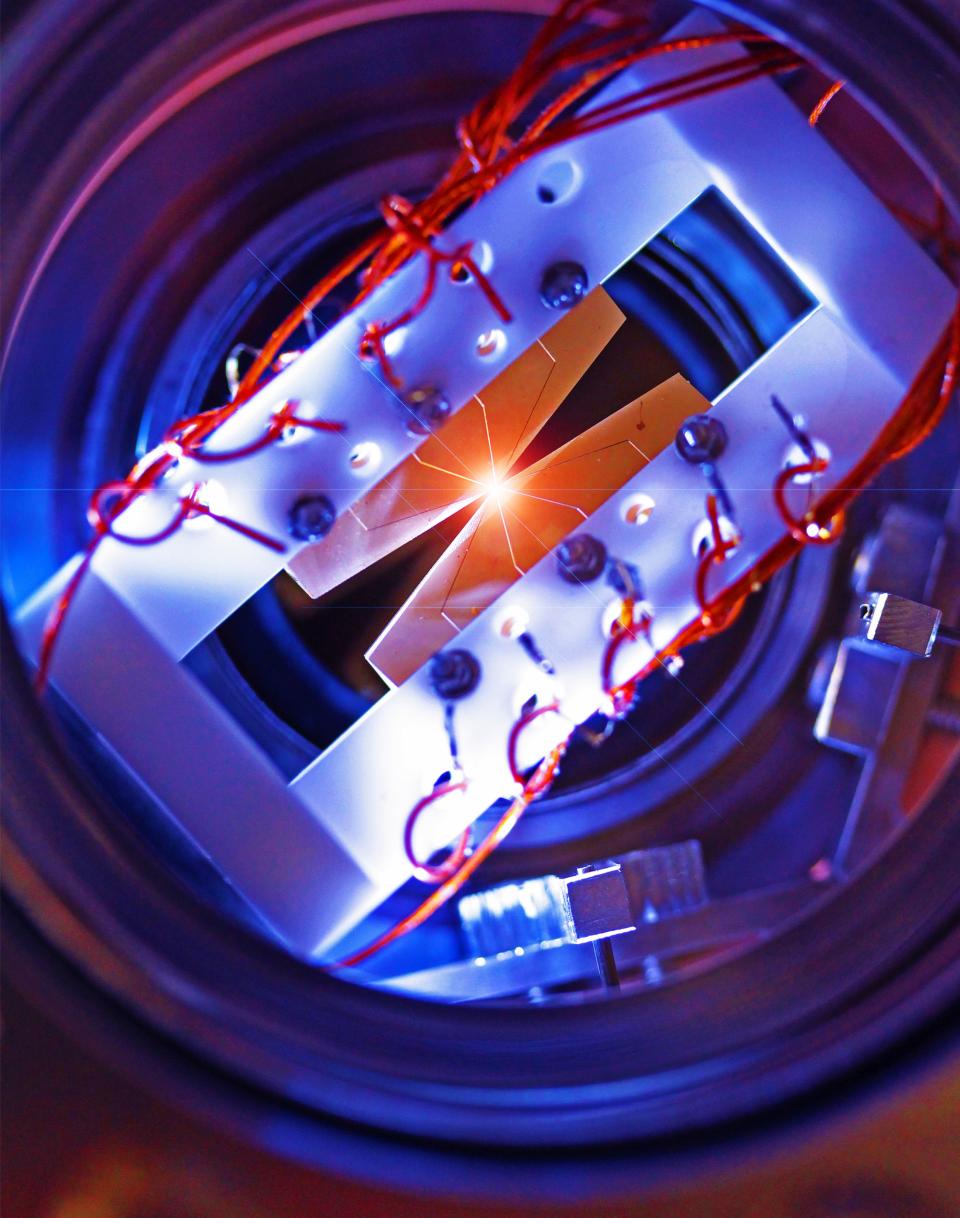New "Flexible" Quantum Computer Can Be Reprogrammed with Lasers

The future of the quantum computer is already bright, but this new variation on the ultra-powerful new tech can do what none other can: It can be reprogrammed on the fly to crunch new algorithms.
While computer scientists worldwide have already built dozens of small, simple quantum computers-machines that use the mind-bending physics of atoms to solve complex math in simple steps-they've been almost entirely "rigid" devices. Basically single-use computers that can't be reprogrammed to do new things after they've been built. But a team of scientists led by Shantanu Debnath at the University of Maryland has just built a "flexible" quantum computer, as detailed in a paper published today in the journal Nature. Make no mistake, it's a hell of a feat.
To understand why Debnath's new, flexible quantum computer is so cool, it helps to understand how exactly quantum computers work.
When you dive down into the circuits, all modern computers basically function the same way. Simply put, they shuffle data around using a few simple rules. All that data is made up of bits-single fragments of information with one of two binary states. In your computer, these bits represent either 1s or 0s. Like a light-bulb that's either on or off.
Quantum computers take advantage of something fantastically strange. Quantum theory‚ the physics that rules the tiny world of atoms and particles‚ tells us that there are certain circumstances under which a piece of matter can be two things at the same time. You can have an atom that's spinning in two opposite directions at once. Or a light-bulb that shining and not shining at the same time. If this sounds like a total farce, you're sufficiently appreciating quantum theory. Physicist Niels Bohr once said, "Those who are not shocked when they first come across quantum theory cannot possibly have understood it."
"Those who are not shocked when they first come across quantum theory cannot possibly have understood it."
A quantum computer basically leverages that weird dual state of matter-called superposition-so that its bits of information aren't just 1s and 0s, but can also be a combo of both. This is called a quantum bit, or a qubit. Using qubits could theoretically allow computers to crunch insanely difficult computational problems in single steps by drastically increasing the amount of data that can be moved at once.
Debnath's quantum computer works by stringing five qubits in a line, and using lasers to manipulate them. These qubits are basically just tightly-trapped atoms of the element ytterbium. By shining a laser on the atoms with an exact staccato pulse of light, you can throw them into superposition-the state where they're doing two opposite things at the same time such as spinning in two directions with different angular momentum. That's where the quantum principle called entanglement comes in.

To (over)simplify it, entanglement describes the downright strange fact that different pieces of matter in superposition can actually be tied together-so that if one piece falls out of superposition, the other will automatically fall out of superposition as well. Imagine you and I both have a light-bulb in one of the weird dual states that quantum physics allows. If they are entangled, when you smack your bulb out of superposition (say, by turning it all the way off), my bulb would turn off as well. Even weirder, this entanglement still works when the particles are extremely far apart, and it happens instantaneously.
In this new quantum computer, Debnath's team can use different pulses of laser light to entangle different pairs of the qubit atoms together-even ones not next to one another in a line-so that if something happens to one, it also effects the other. Basically, the scientists can force different atoms to share a piece of arbitrary information.
This is what allows the computer to tackle different problems and be programmed with new algorithms. Normally you'd have to physically rearrange your quantum computer's parts to adjust it to run different problems. But the laser-based setup of Debnath's quantum computer allows him to fire lasers at any of his five 5 qubits, entangling pairs of qubits together in whatever order he wants.
This flexibility allows Debnath's team to rapidly re-program their computer to solve different problems and run different algorithms.
This flexibility allows Debnath's team to rapidly re-program their computer to solve different problems and run different algorithms. And if they come up with a new algorithm they'd like to run, all they have to do is figure out which atoms need to be entangled and in what order, and then let the lasers do the rest.
According to Stephen D. Bartlett-a physicist at the University of Sydney, Australia- who wrote an essay on Debnath's new computer that accompanied the Nature paper, Debnath's team "demonstrated several algorithms. [Including two] which both use quantum effects to perform a mathematical calculation in a single step, whereas a conventional computer would require several operations. They also demonstrate a quantum Fourier transform, which is a key component of many of the heftier quantum algorithms, such as those used to break encryption," Bartlett writes.
Debnath and his colleagues are still a long ways from where we'd like to be with quantum computers. Their machine can only handle small algorithms, and gives answers more slowly than even the most sluggish traditional computer. One reason is that Debnath's new computer only uses 5 qubits, and researchers hope one day to see quantum computers that use millions of qubits, or more. But having a quantum computer that can be reprogrammed without being physically disassembled and reconstructed is a good start.
You Might Also Like

